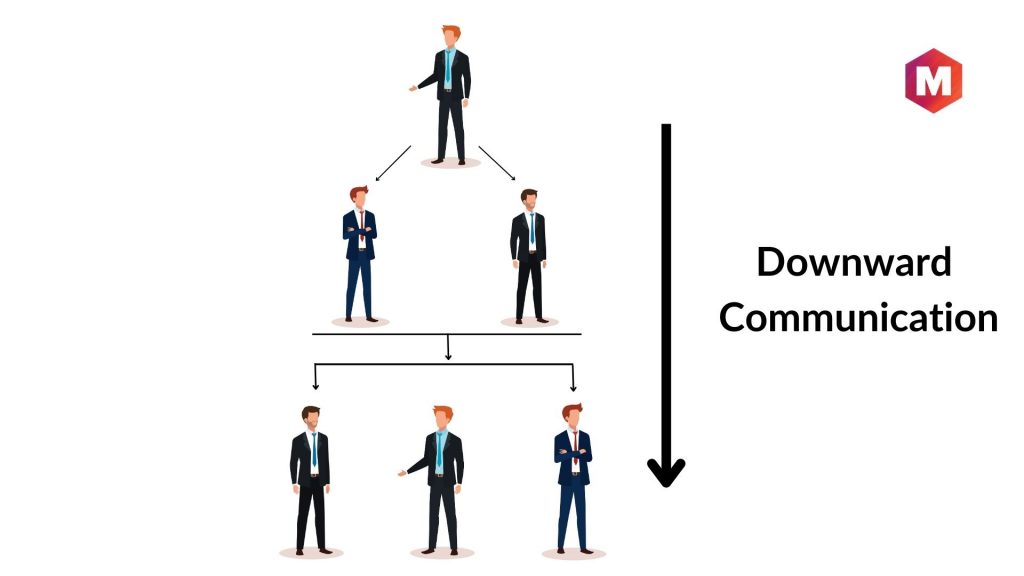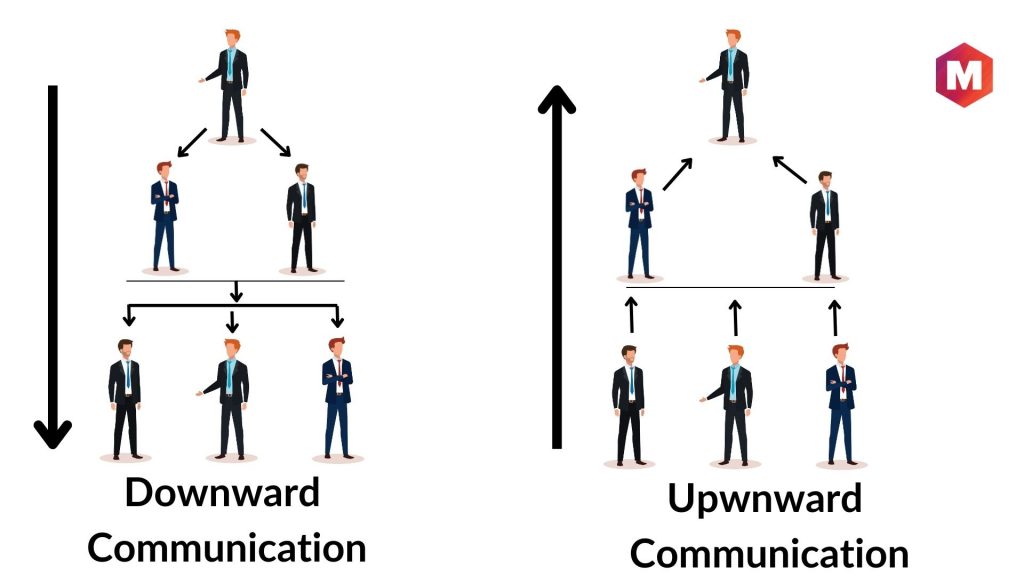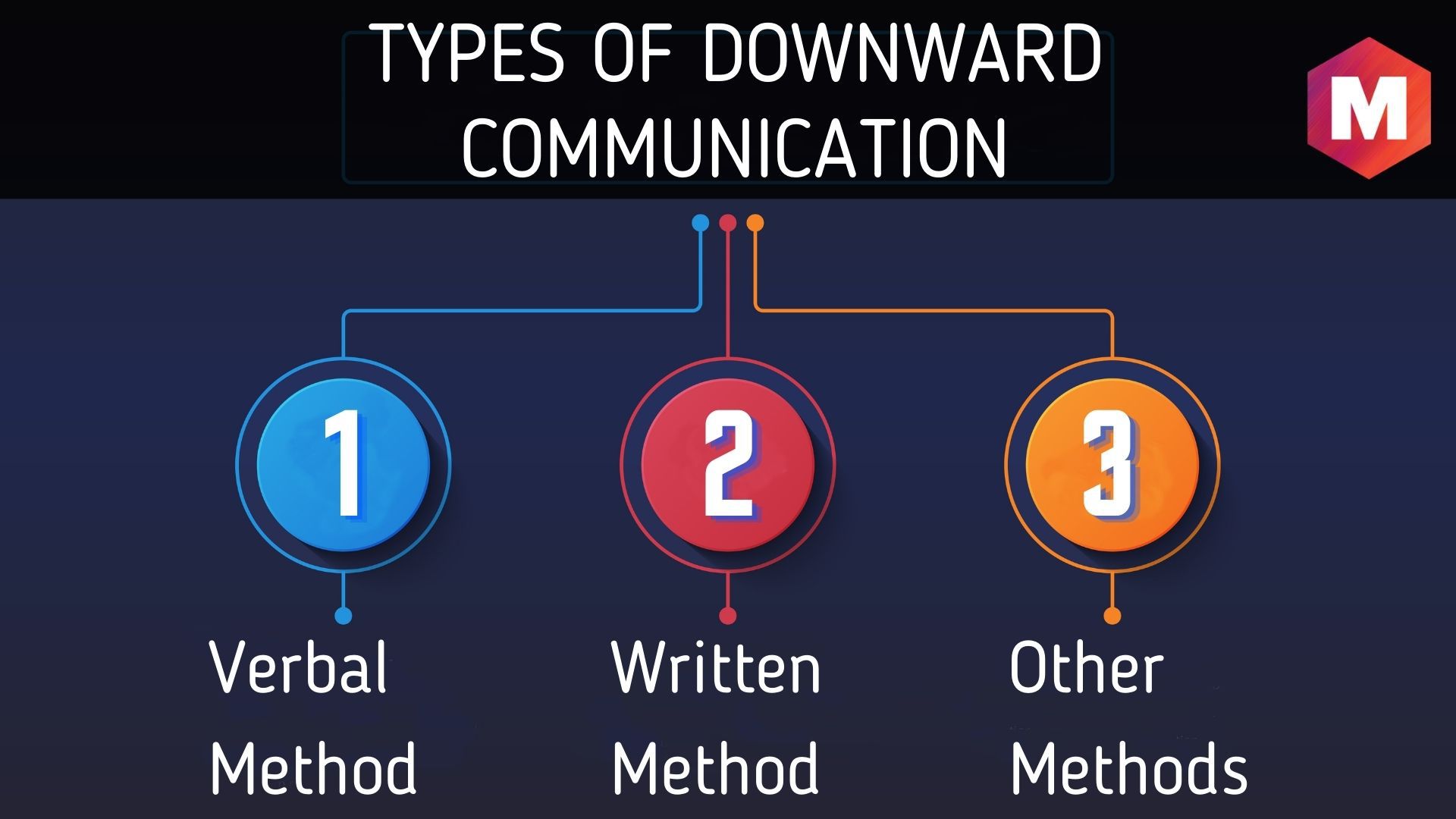Downward communication is the procedure in which information or chain of command circulates from an organization’s upper level of hierarchy to the lower level. It occurs when information and messages flow down by using the formal chain of command or hierarchical structure of an organization.
In level management of communication downward, messages and orders start from the top-level management of the company and move down toward the lower-level employees. The superiors responsible for upper management like managers, directors, or CEOs convey organizational goals, procedures, policies, orders, decisions, instructions, etc., to their subordinates through downward communication.
For example, a manager of an organization channelizes business communication issuing any instructions to his or her assistant manager or supervisor providing directions to his workers.
Table of Contents
What is Downward Communication?
Definition: Downward communication is defined as a formal process of passing information from top-level management to employees through a chain of instructions. The downward communication flow starts with someone at the helm issuing information or message, and the following lower person in the hierarchy passes it to those who report to the higher one.
In other words, it can be understood as an effective communication style in an organizational setup that takes place from superiors to subordinates. This flow goes on down the line. The management of any organization relies on downward communication for most of the communications.
Effective downward communication plays an essential and crucial part in an organization’s success. It helps in establishing and disseminating the goals of an organization.
How Does Downward Communication Work?
Downward communication refers to the process of sharing information with a lower-level employee. It’s a way of providing information that helps the person in question perform their job more effectively or efficiently.
For example, if you’re a manager at a company, you might have to communicate down to your employees and tell them what’s going on with their job or what they need to do next.
Here’s how it works:
1) Think about the information you want to communicate downward.
2) Decide on the best way to deliver that information—whether it’s face to face conversations, over email, or through another medium.
3) Make sure that you have clear communication goals in mind before reaching out to your audience; for example, if you’re sending an email, be sure that it contains all of the necessary information for them to understand what’s going on and what they need to do next.
Downward Communication vs Upward Communication
As the name suggests, in upward communication, the information flowing process starts from the lower level of a hierarchy and ends at the top-level management. For instance, in a company, it will start with an employee.
While communication downward is the exact opposite of the process in which information and messages flow from managers and leaders to the followers and employees. For example, in a team, written communication will start with a leader.
Purpose of using Downward Communication
Five general purposes because of which an organization should choose downward communication are
1. Finding the right ways to implement goals, strategies, and objectives
It helps the organization in communicating the mission, vision, messages, and objectives decided by top-level management to the lower-level employees using the internal channels of communication in an organizational environment.
2. Sharing job instructions and rationale
It assists in the process of sharing directives concerning how to perform a job or coordinating individual as well as departmental objectives.
3. Communicating procedures and practices
Businesses or organizations use different policies, regulations, rules, benefits, guidelines, structural arrangements, etc, and share it using communication downward from top to lower levels. It ensures some degree of uniformity in organization practices.
4. Sharing progress reports and performance feedback
Organizations or companies use this form of communication for sharing departmental progress reports as well as individual performance feedback and appraisals. Managers share feedback to employees about how well they are performing as per their performance goals and standards.
5. Improving socialization
Organizations incorporate strategies to motivate employees and they use downward communication for sharing those strategies. The mission and cultural values of organizations are shared with staff members. They are also asked to participate in special ceremonies and events that help everyone to socialized and familiarize themselves by having a sense of belonging and unity of direction.
Types of Downward Communication
While transmitting pieces of information, principally used communications are oral and written communication. The segment of media depends on its nature and urgency.
1. Oral or Verbal Method
Mainly, Downward Communication occurs by an oral method. The higher authority gives instructions to their subordinates through telephonic conversation or face-to-face. The managers also can exchange relevant information with their subordinates through conferences, meetings, lectures, etc.
2. Written Method
Organizations, irrespective of their size and nature, send important messages and information to their employees in written forms through circulars, manuals, letters, bulletins, posters. Usually, letters communicate necessary organizational directives; Manuals, circulars, and bulletins communicate procedures and policies.
3. Other Methods
Inclusions to oral and written methods, audio, visual and audio-visual media are also used in downward communication. Television, radio, poster, signal, graphs, etc., are some of the commonly used mediums that transfer information to the subordinates. In this digital era, emails, PPT, messages (SMS), WhatsApp, etc., can be included here.
Importance of Downward Communication
In an organization, employing Downward Communication channels are crucial and effective.
1. Providing an Idea
A superior person sitting at the helm of an organization can give and transfer a complete understanding to his/her subordinates through downward communication regarding rules, policies, objectives, decisions, and many more.
2. Motivating with Objectives
An organization can resort to downward communication to encourage lower-level workers or employees. It motivates the employees to work more and perfect for an organization to achieve goals and objectives.
3. Maintaining a Discipline
Downward communication follows an organizational hierarchy. Every department follows the set rules or procedures. In this way, discipline is maintained in an organization.
4. Explaining about Change
When there is any change in respect of works, plans, procedures, policies, rules timings, etc., downward communication is the most looked forward communication that explains changes.
5. Giving Direction and Assigning a Job
Superior can direct any assignment, work-related things, tasks through downward communication to their subordinates. Assigning jobs to the employees can be given through Downward Communication by the superiors.
6. Evaluating Works
Downward communication helps superiors to evaluate works performed by their employees. Through Downward communication, employees are informed of their evaluations.
Examples and Mediums of Downward communication
Here are a few examples of the downward communication
- A manager sending an email to inform employees, outlining the company’s new strategy and how it will affect workers’ jobs.
- A supervisor telling an employee that he/she needs to improve his/her performance or else he/she will be fired.
- A boss telling an employee that he/she will be working on a new project for the next few months.
- A manager telling employees about the company’s new benefit plan and how it will affect their healthcare costs.
Tips on How to Make Downward Communications Successful
If you’re someone who’s in charge of making sure that downward communication flows happen effectively, here are some tips for how to make it successful:
1) Make sure you’re talking about the right things — When you’re having a conversation with your team members, make sure you talk about what they need to know (and not just your own opinions).
2) Make sure they understand why they’re doing something — If you’re asking your team members to do something new or different, then you have to make sure they understand why they’re doing it. If there’s something specific that needs changed, explain it clearly and succinctly so everyone understands why it matters.
3) Be respectful — Always treat others with respect and do your best not to interrupt or talk over them during these conversations.
Advantages of Effective Downward Communication
1. Efficiency
Downward communication provides effectiveness and coherence because information and instructions came from the sources in power. It enables the coordination of activities from the higher part of the organization, thus maintaining the efficiency of the employees.
2. Easy and effective delegation
The delegation becomes so easier and effective coming from the superiors to the employees representing a chain of commands.
3. Organizational Control and Discipline
As downward communication follows the organization’s hierarchy, control, discipline, and members’ compliance become much easier to preserve.
4. Builds Good Relationships
Downward communication builds good relationships between the hierarchy. A strong feeling of participation happens in this communication for the subordinates.
Disadvantages of Downward Communication
1. Distortion
As information proceeds through different levels of the organization from the vertical communication structure, chances of distorted information and messages can be there.
2. Loss of Information
The possibility of losing information is quite there in this type of communication.
3. Time Consuming
It takes time for information to be transferred from one stratum of employees to another, so feedback can be slow, resulting in time loss.
4. Lowers Morale
Downward communication, in some ways, can have a negative impact when supervisors misuse their position and power, so it can result in lowering the morale of employees.
Conclusion
Now, it is clear that downward communication is crucial for supplying information, assigning work, explaining policies/pans, and directing subordinates in an organization.
It is also useful in distributing interdepartmental duties and responsibilities, explaining the changing environment, sharing performance evaluation, delegating authority, and establishing discipline.
How important do you consider downward communication for sharing ideas and completing tasks in an organization?
Liked this post? Check out the complete series on Communication





I learned a lot about leaders, different types of leadership that is very important in this line of career and communications and techniques how too maneuver in life.
How the reference of communicationis